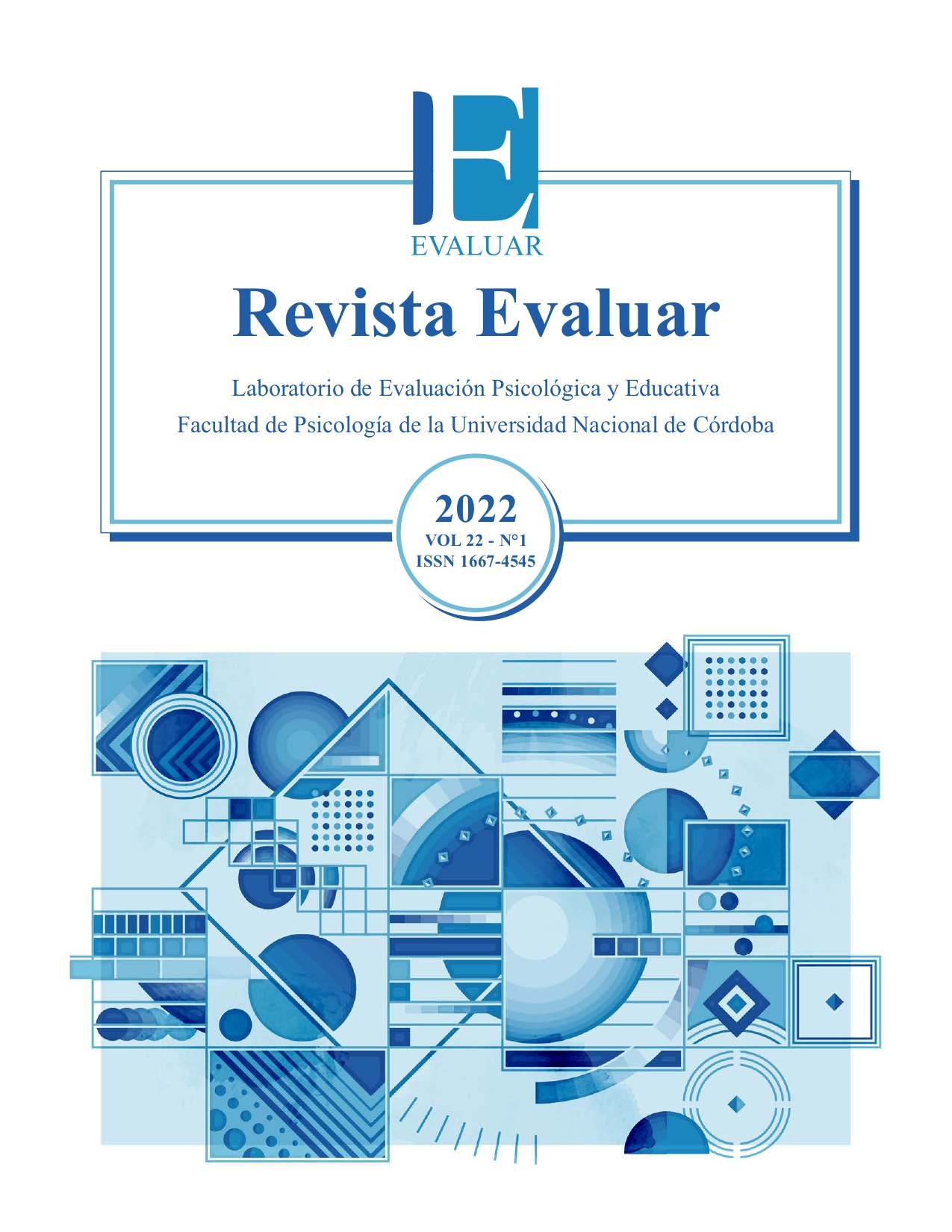Development of a short version of the Coping Strategies Inventory
DOI:
https://doi.org/10.35670/1667-4545.v22.n1.37412Keywords:
coping, confirmatory factor analysis, convergent validity, measurement invariance, psychometric propertiesAbstract
When an external and/or internal demand is perceived as exhausting individual resources, certain strategies are used to cope with the stress involved. One of the strategies most associated with certain pathological conditions is emotional repression. Despite this, there are no brief instruments in Spanish that evaluate this stress coping strategy. Therefore, the aim of the present study was to develop a brief version of the Coping Strategies Inventory that contains only three items for each factor. The sample (N = 762) was collected online and divided into two parts. The first was used to conduct an exploratory factor analysis, which showed the existence of eight dimensions. For all subsequent analyses, the second part of the sample was used. The results of the confirmatory factor
analysis showed not only adequate psychometric properties, but also the suitability of using the instrument with a first-order factor
structure rather than a higher-order one. In order to test convergent validity, significant correlations were found with all personality
traits. It is concluded that the development of a short version of the Coping Strategies Inventory was successful, as all psychometric
indices reached values equal to or even higher than the original version with more items.
Downloads
References
Beyer, A., & Lohaus, A. (2007). Konzepte zur Stressentstehung und Stressbewältigung im Kindes-und Jugendalter. En I. Seiffge-Krenke & A. Lohaus (Eds.), Stress und Stressbewältigung im Kindes-und Jugendalter (pp. 11-27). Göttingen, Alemania: Hogrefe.
Byrne, B. M. (2016). Structural Equation Modeling with AMOS (3ra ed.). doi: 10.4324/9781315757421
Cano-García, F. J., Rodríguez-Franco, L., & García-Martínez, J. (2007). Adaptación española del Inventario de Estrategias de Afrontamiento. Actas Españolas de Psiquiatría, 35(1), 29-39. Recuperado de https://actaspsiquiatria.es
Carver, C. S. (1997). You want to measure coping but your protocol’ too long: Consider the brief cope. International Journal of Behavioral Medicine, 4, Artículo 92. doi: 10.1207/s15327558ijbm0401_6
Carver, C. S., Scheier, M. F., & Weintraub, J. K. (1989). Assessing coping strategies: A theoretically based approach. Journal of Personality and Social Psychology, 56(2), 267-283. doi: 10.1037/0022-3514.56.2.267
Chen, F. F. (2007). Sensitivity of goodness of fit indexes to lack of measurement invariance. Structural Equation Modeling: A Multidisciplinary Journal, 14(3), 464-504. doi: 10.1080/10705510701301834
Cheung, G. W., & Rensvold, R. B. (2002). Evaluating goodness-of-fit indexes for testing measurement invariance. Structural Equation Modeling: A Multidisciplinary Journal, 9(2), 233-255. doi: 10.1207/S15328007SEM0902_5
Cohen, J. (1988). Statistical power analysis for the behavioral sciences (2da ed.). New York, NY: Lawrence Erlbaum Associates.
Compas, B. E., Connor-Smith, J. K., Saltzman, H., Thomsen, A. H., & Wadsworth, M. E. (2001). Coping with stress during childhood and adolescence: Problems, progress, and potential in theory and research. Psychological Bulletin, 127(1), 87-127. doi: 10.1037/0033-2909.127.1.87
Compas, B. E., Jaser, S. S., Bettis, A. H., Watson, K. H., Gruhn, M. A., Dunbar, J. P., … & Thigpen, J. C. (2017). Coping, emotion regulation, and psychopathology in childhood and adolescence: A meta-analysis and narrative review. Psychological Bulletin, 143(9), 939-991. doi: 10.1037/bul0000110
Costello, A. B., & Osborne, J. (2005). Best practices in exploratory factor analysis: Four recommendations for getting the most from your analysis. Practical Assessment, Research, and Evaluation, 10, Artículo 7. doi: 10.7275/jyj1-4868
Dunn, T. J., Baguley, T., & Brunsden, V. (2014). From alpha to omega: A practical solution to the pervasive problem of internal consistency estimation. British Journal of Psychology, 105(3), 399-412. doi: 10.1111/bjop.12046
Eschenbeck, H., Kohlmann, C.-W., & Lohaus, A. (2007). Gender differences in coping strategies in children and adolescents. Journal of Individual Differences, 28(1), 18-26. doi: 10.1027/1614-0001.28.1.18
Fabrigar, L. R., Wegener, D. T., MacCallum, R. C., & Strahan, E. J. (1999). Evaluating the use of exploratory factor analysis in psychological research. Psychological Methods, 4(3), 272-299. doi: 10.1037/1082-989X.4.3.272
Fokkema, M., & Greiff, S. (2017). How performing PCA and CFA on the same data equals trouble. European Journal of Psychological Assessment, 33(6), 399-402. doi: 10.1027/1015-5759/a000460
Folkman, S., & Lazarus, R. S. (1988). Ways of Coping Questionnaire (WAYS). APA PsycTESTS Dataset. doi: 10.1037/t06501-000
Griffith, M. A., Dubow, E. F., & Ippolito, M. F. (2000). Developmental and cross-situational differences in adolescents’ coping strategies. Journal of Youth and Adolescence, 29(2), 183-204. doi: 10.1023/A:1005104632102
Gross, J. J. (2014). Emotion regulation: Conceptual and empirical foundations. En J. J. Gross (Ed.), Handbook of emotion regulation (2da ed., pp. 3-20). New York, NY: The Guilford Press.
Gross, J. J., & John, O. P. (2003). Individual differences in two emotion regulation processes: Implications for affect, relationships, and well-being. Journal of Personality and Social Psychology, 85(2), 348-362. doi: 10.1037/0022-3514.85.2.348
Guarino, L., Sojo, V., & Bethelmy, L. (2007). Adaptación y validación preliminar de la versión hispana del Cuestionario de Estilos de Afrontamiento (Coping Style Questionnaire). Psicología Conductual, 15(2), 173-189. Recuperado de https://www.behavioralpsycho.com
Hair, J. F., Black, W. C., Babin, B. J., & Anderson, R. E. (2019). Multivariate data analysis (8va ed.). Boston, MA: Cengage.
Hinton, P., McMurray, I., & Brownlow, C. (2014). SPSS Explained (2da ed.). doi: 10.4324/9781315797298
Hofmann, R. J. (1978). Complexity and simplicity as objective indices descriptive of factor solutions. Multivariate Behavioral Research, 13(2), 247-250. doi: 10.1207/s15327906mbr1302_9
Hu, L.-T., & Bentler, P. M. (1999). Cutoff criteria for fit indexes in covariance structure analysis: Conventional criteria versus new alternatives. Structural Equation Modeling: A Multidisciplinary Journal, 6(1), 1-55. doi: 10.1080/10705519909540118
Kato, T. (2015). Frequently used coping scales: A meta-analysis. Stress and Health: Journal of the International Society for the Investigation of Stress, 31(4), 315-323. doi: 10.1002/smi.2557
Klein-Heßling, J., & Lohaus, A. (2002). Zur situationalen Angemessenheit der Bewältigung von Alltagsbelastungen im Kindes-und Jugendalter. Kindheit Und Entwicklung: Zeitschrift Für Klinische Kinderpsychologie, 11(1), 29-37. doi: 10.1026//0942-5403.11.1.29
Korkmaz, S., Goksuluk, D., & Zararsiz, G. (2014). MVN: An R package for assessing multivariate normality. The R Journal, 6(2), 151-162. doi: 10.32614/RJ-2014-031
Lazarus, R. S. (1993). Coping theory and research: Past, present, and future. Psychosomatic Medicine, 55(3), 234-247. doi: 10.1097/00006842-199305000-00002
Lazarus, R. S., & Folkman, S. (1984). Stress, appraisal, and coping. New York, NY: Springer.
Leys, C., Klein, O., Dominicy, Y., & Ley, C. (2018). Detecting multivariate outliers: Use a robust variant of the Mahalanobis distance. Journal of Experimental Social Psychology, 74, 150-156. doi: 10.1016/j.jesp.2017.09.011
Mardia, K. V. (1970). Measures of multivariate skewness and kurtosis with applications. Biometrika, 57(3), 519-530. doi: 10.1093/biomet/57.3.519
Marsh, H. W., Hau, K.-T., & Wen, Z. (2004). In search of golden rules: Comment on hypothesis-testing approaches to setting cutoff values for fit indexes and dangers in overgeneralizing Hu and Bentler’s (1999) findings. Structural Equation Modeling: A Multidisciplinary Journal, 11(3), 320-341. doi: 10.1207/s15328007sem1103_2
Meade, A. W., Johnson, E. C., & Braddy, P. W. (2008). Power and sensitivity of alternative fit indices in tests of measurement invariance. Journal of Applied Psychology, 93(3), 568-592. doi: 10.1037/0021-9010.93.3.568
Mezzadra, J., & Simkin, H. (2017). Validación de la Escala Abreviada de Afrontamiento Religioso Brief-RCOPE en el contexto argentino en estudiantes de confesión católica. Revista Evaluar, 17(1), 18-28. doi: 10.35670/1667-4545.v17.n1.17071
Montero, I., & León, O. G. (2007). A guide for naming research studies in Psychology. International Journal of Clinical and Health Psychology, 7(3), 847-862. Recuperado de https://www.redalyc.org
Morán-Astorga, C., Landero-Hernández, R., & González-Ramírez, M. T. (2010). COPE-28: Un análisis psicométrico de la versión en español del brief COPE. Universitas Psychologica, 9(2), 543-552. doi: 10.11144/Javeriana.upsy9-2.capv
Pagán-Torres, O. M., Cumba-Avilés, E., Rosario-Hernández, E., & González-Rivera, J. A. (2021). Psychometric properties and factor structure of the Brief Religious Coping Scale (Brief-RCOPE) in Puerto Rican adults. Revista Evaluar, 21(2), 48-62. doi: 10.35670/1667-4545.v21.n2.34396
R Core Team. (2020). R: A language and environment for statistical computing. Recuperado de https://www.r-project.org
Revelle, W. (2021). psych: Procedures for Psychological, Psychometric, and Personality Research. Recuperado de https://cran.r-Project.org/package=psych Version = 1.9.12
Rodríguez-Marín, J., Terol-Cantero, M. C., López-Roig, S., & Pastor-Mira, M. Á. (1992). Evaluación del afrontamiento del estrés: Propiedades psicométricas del Cuestionario de Formas de Afrontamiento de Acontecimientos Estresantes. Journal of Health Psychology, 4(2), 59-84. Recuperado de http://hdl.handle.net/10045/97146
Rosseel, Y. (2012). lavaan: An R Package for Structural Equation Modeling. Journal of Statistical Software, 48(2), 1-36. doi: 10.18637/jss.v048.i02
Roth, S., & Cohen, L. J. (1986). Approach, avoidance, and coping with stress. American Psychologist, 41(7), 813-819. doi: 10.1037/0003-066X.41.7.813
Sandín, B., & Chorot, P. (2003). Cuestionario de Afrontamiento del Estrés (CAE): Desarrollo y validación preliminar. Revista de Psicopatología y Psicología Clínica, 8(1), 39-53. doi: 10.5944/rppc.vol.8.num.1.2003.3941
Satorra, A., & Bentler, P. M. (2001). A scaled difference Chi-Square Test statistic for moment structure analysis. Psychometrika, 66(4), 507-514. doi: 10.1007/BF02296192
Simkin, H., Borchardt-Dutera, L., & Azzollini, S. (2020). Evidencias de validez del Compendio Internacional de Ítems de Personalidad Abreviado. Liberabit: Revista Peruana de Psicología, 26(1), e320. doi: 10.24265/liberabit.2020.v26n1.02
Stassen, H. H., Delfino, J. P., Kluckner, V. J., Lott, P., & Mohr, C. (2014). Vulnerabilität und psychische Erkrankung. Schweizer Archiv Für Neurologie Und Psychiatrie, 165(5), 152-157. doi: 10.4414/sanp.2014.00261
Tobin, D. L., Holroyd, K. A., Reynolds, R. V., & Wigal, J. K. (1989). The hierarchical factor structure of the Coping Strategies Inventory. Cognitive Therapy and Research, 13(4), 343-361. doi: 10.1007/BF01173478
Venables, W. N., & Ripley, B. D. (2002). Modern Applied Statistics with S. doi: 10.1007/978-0-387-21706-2
Yu, C.-Y. (2002). Evaluating cutoff criteria of model fit indices for latent variable models with binary and continuous outcomes (Disertación doctoral). University of California, Los Ángeles, CA.
Downloads
Published
How to Cite
Issue
Section
License
Copyright (c) 2022 Christian Schetsche, Luis Carlos Jaume, Susana Celeste Azzollini

This work is licensed under a Creative Commons Attribution 4.0 International License.
Revista Evaluar aplica la Licencia Internacional de Atribuciones Comunes Creativas (Creative Commons Attribution License, CCAL). Bajo esta licencia, los autores retienen la propiedad de copyright de los artículos pero permiten que, sin que medie permiso de autor o editor, cualquier persona descargue y distribuya los artículos publicados en Evaluar. La única condición es que siempre y en todos los casos se cite a los autores y a la fuente original de publicación (i.e. Evaluar). El envío de artículos a Evaluar y la lectura de los mismos es totalmente gratuito.




_(3).jpg)



.jpg)



